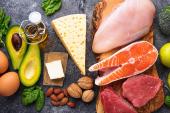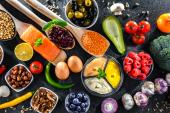High-Protein Diets Linked to Amino Acid Activation of ASCVD Pathway
The study implicates leucine as a “bad actor” in a cascade of cellular events that kick off when too much protein is consumed.

A protein-heavy diet may increase cardiovascular disease risk by setting off an immune response that drives atherosclerotic plaque formation, new research suggests.
When more than 22% of daily calories came from protein—or more than about 25 grams per meal—levels of the amino acid leucine increased in humans and mice, report investigators. They further observed that leucine activated mammalian target of rapamycin (mTOR) signaling in macrophages, a pathway that the same researchers previously implicated in the pathogenesis of ischemic CVD.
“Of all the amino acids, some are very weak activators of mTOR in macrophages, but it's leucine that is the bad actor here,” senior study author Babak Razani, MD, PhD (University of Pittsburgh School of Medicine, PA), told TCTMD.
Razani said that several prospective studies have linked high protein intake to increased cardiovascular risk, with theories postulating that either red meat in particular or the fat content of animal protein may be responsible for contributing to atherosclerotic cardiovascular disease (ASCVD). Here, however, the researchers showed in a preclinical mouse model that accelerated ASCVD progression was associated with high levels of leucine independent of total carbohydrate and protein.
“When you added [leucine] back, atherosclerosis went up. When you subtracted it, atherosclerosis went down,” Razani noted, adding that the observations regarding the leucine mechanism need confirmation in larger human studies.
The study, led by Xiangyu Zhang, PhD (University of Pittsburgh School of Medicine), was published in Nature Metabolism.
In an accompanying commentary, Adam J. Rose, PhD, and Patricia M. Rusu, PhD (Monash University, Melbourne, Australia), say the findings ultimately “could spur the development of therapeutic strategies that are intended to specifically lower leucine supply, through a ‘designer’ diet (for example, designed to be low in specific amino acids) or otherwise.”
At a cellular level, Rose and Rusu say, activation of the mTOR pathway by high levels of leucine in protein-rich diets “could affect several aspects of myeloid cell characteristics that promote eventual atherosclerosis risk, within and outside of the atherosclerotic niche.”
Clinical Implications
The human testing in the study involved giving smoothie drinks to participants on two occasions then collecting blood samples to check leucine levels and mTOR activation. In the first experiment, involving 14 people, the smoothie contained 10% of energy as protein (low-protein drink), and in the second experiment, with nine individuals, it contained 50% of energy as protein (very-high-protein drink).
While the low-protein drink had no impact on monocyte mTOR activation, the effect of the very-high-protein drink was evident within 1 to 3 hours of consuming it.
To TCTMD, Razani said while he doesn’t advise on the basis of this study that people on high-protein diets make radical changes, especially if they have been instructed by physicians or nutritionists to eat that way for weight loss, it is important to understand that consuming very high levels of protein consistently could take a toll on vascular health over time.
For those who are protein loading to build muscle, Razani said there likely is a “sweet spot” where it is possible to build muscle without activating the immune cells.
“We don’t know where that sweet spot is, but this is an example of what we should be doing . . . as clinicians to drive the agenda toward precision nutrition,” he added.
According to Rose and Rusu, any ensuing recommendations about limiting protein to avoid high levels of leucine need to be balanced with individual needs, particularly in older individuals so as not to put them at risk for muscle atrophy and frailty.
Razani said the “low-hanging fruit” may be patients who’ve had a cardiovascular event. Testing out low-, moderate-, and high-protein diets could provide more context to help balance preserving their muscle mass with preventing future events.
“Protein is good for our patients, but where is the ‘too high’ limit? Where is the point at which you're actually doing damage in other respects?” he added. Equally important, what happens with leucine levels when protein sources come from plants versus animals? The current study can’t answer that question, but Razani said it will be an important next step in unravelling these questions about healthy versus unhealthy protein limits.
L.A. McKeown is a Senior Medical Journalist for TCTMD, the Section Editor of CV Team Forum, and Senior Medical…
Read Full BioSources
Zhang X, Kapoor D, Jeong S-J, et al. Identification of a leucine-mediated threshold effect governing macrophage mTOR signalling and cardiovascular risk. Nature Metabolism. 2024;6:359-377.
Rose AJ, Rusu PM. A leucine–macrophage mTORC1 connection drives increased risk of atherosclerosis with high-protein diets. 2024;6:203-204.
Disclosures
- Zhang and Razani report no relevant conflicts of interest.
- Rose and Rusu report receiving research funds from Boehringer-Ingelheim for an unrelated research project.






Comments